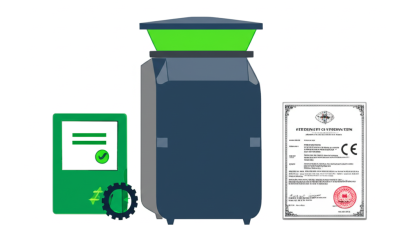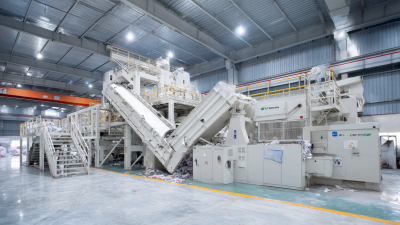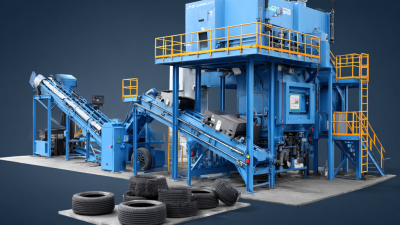In the evolving landscape of modern recycling processes, the efficiency of machinery plays a crucial role in determining the overall effectiveness of waste management systems. The Slow Edge Crusher, a pivotal innovation in material processing, has garnered attention for its ability to enhance recycling output while minimizing energy consumption. According to a report by the National Recycling Coalition, advanced crushing technologies, including Slow Edge Crushers, can improve recycling rates by up to 20%, significantly reducing landfill waste. As industries face increased pressure to adopt sustainable practices, the integration of Slow Edge Crushers offers a promising solution. This technology not only optimizes the size reduction of various materials but also ensures that valuable resources are recovered efficiently, paving the way for circular economy initiatives. The exploration of Slow Edge Crusher efficiency reveals critical insights that can unlock enhanced performance in recycling operations, making it imperative for stakeholders to understand and leverage these advancements.

Slow edge crushers play a crucial role in modern recycling processes by providing efficient and effective material processing. These machines are specifically designed to handle a variety of waste materials, including hard plastics, textiles, and even metals. The key to their functionality lies in their unique design, which features a slow rotational speed that reduces the risk of overheating and ensures a uniform output size. This careful engineering allows for larger pieces of material to be processed without creating excessive dust or fines, making them ideal for recycling facilities focused on maximizing material recovery.
The effectiveness of slow edge crushers can be attributed to their robust construction and advanced features. Typically equipped with dual or multiple shafts, these crushers utilize a series of specially designed blades that slice through materials while minimizing wear and tear. Their gradual processing mechanism ensures that the material is not only broken down but also prepped for subsequent recycling stages, such as shredding or granulation. Furthermore, the incorporation of programmable controls enhances operational efficiency, allowing operators to adjust settings based on the specific characteristics of the input materials, ultimately leading to a more streamlined recycling operation.
The efficiency of slow edge crushers in modern recycling processes is significantly impacted by several key factors that warrant attention. First and foremost, material properties play a crucial role. The composition, size, and moisture content of the recyclable materials can influence the crushing performance. For instance, harder materials may require more energy to process, thus reducing overall efficiency. Additionally, an appropriate feed size is essential; oversize materials can obstruct the crushing chamber, leading to increased wear and reduced throughput.
Another factor affecting crusher efficiency is the operational speed of the machinery. Slow edge crushers are designed for specific applications where controlled throughput is necessary, but running them too slowly can result in inadequate processing of materials. Conversely, a well-calibrated speed can optimize the balance between energy consumption and effective material breakdown. Moreover, regular maintenance of the crusher is vital; worn blades or misalignments can hinder performance and lead to inefficiencies. By meticulously managing these factors, recycling facilities can unlock the full potential of slow edge crushers, enhancing their contributions to sustainable waste management practices.
| Key Factor | Description | Impact on Efficiency (%) | Optimal Range |
|---|---|---|---|
| Blade Material | Quality of the material used for blades affects the wear and tear, influencing efficiency. | 15-25% | High carbon steel or carbide options |
| Operational Speed | Speed at which the crusher operates, impacting particle size reduction. | 20-30% | 100-200 RPM |
| Material Composition | Diversity in composition affects how materials interact with the crusher. | 10-20% | Homogenous feeding |
| Maintenance Frequency | Regular maintenance extends the life of the crusher and maintains efficiency. | 25-35% | Every 100 operating hours |
| Loading Technique | How material is loaded impacts the flow and crushing process. | 5-15% | Even distribution |
In today’s recycling industry, maximizing the efficiency of slow edge crushers is crucial for optimizing material recovery and reducing operational costs. According to a 2022 report by the Recycling Efficiency Council, implementing best practices can lead to a 20% increase in processing efficiency. Key factors include maintaining proper blade alignment and ensuring optimal feed rates, as even minor adjustments can significantly influence the performance of the equipment. Regular maintenance schedules, coupled with real-time monitoring systems, allow operators to detect issues before they escalate, thus preventing costly downtime.

Additionally, the integration of advanced technologies such as smart sensors and automation can further enhance slow edge crusher performance. A study by the International Society for Recycling Technology found that facilities utilizing automated controls reported a 30% reduction in energy consumption. These systems not only optimize the operational parameters but also adapt to varying feedstock characteristics, ensuring consistent output quality. By focusing on these best practices and embracing technological innovations, recycling facilities can unlock the full potential of their slow edge crushers, driving sustainability and profitability in the recycling process.
Monitoring and maintaining slow edge crushers is crucial for achieving optimal output in modern recycling facilities. These machines play a vital role in processing various materials, yet their efficiency can often be hindered by a lack of regular oversight and proper maintenance protocols. Effective monitoring systems can help track performance metrics such as throughput, power consumption, and wear rates, allowing operators to identify potential issues before they escalate into costly downtimes.
Implementing scheduled maintenance routines is another key aspect of maximizing slow edge crusher efficiency. Regular inspections and timely replacement of worn components not only enhance machine performance but also prolong the equipment's lifespan. Operators should focus on critical parts like blades and bearings, ensuring they remain sharp and properly lubricated. By fostering a proactive maintenance culture and utilizing real-time data tracking, recycling facilities can significantly boost their slow edge crushers’ output, ultimately contributing to a more sustainable recycling process.
This chart illustrates the efficiency of slow edge crushers across four quarters, highlighting a steady improvement in operational output as monitoring and maintenance practices are optimized for modern recycling processes.
Innovative technologies play a crucial role in enhancing the efficiency of slow edge crushers within modern recycling processes. By integrating advanced automation and machine learning algorithms, facilities can optimize crusher performance, accurately predicting when maintenance is required and preventing unexpected downtimes. These technologies enable real-time monitoring of the crushing process, allowing recyclers to adjust parameters dynamically based on material characteristics, thus maximizing output and minimizing energy consumption.
Moreover, the incorporation of materials characterization techniques, such as X-ray fluorescence and infrared spectroscopy, aids in the efficient separation of diverse materials. This ensures high purity in recycled outputs and reduces contamination rates. Additionally, the use of smarter designs in crusher mechanics promotes uniform material feeding, leading to more consistent crushing cycles. Collectively, these innovative advancements contribute significantly to streamlining recycling operations, reducing operational costs, and increasing overall sustainability in waste management practices.







